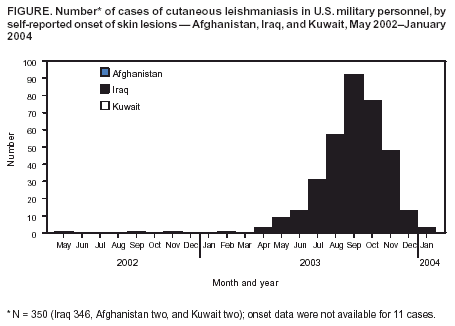 |
|
|
|
|
|
|
|
|
|
|
|
|
|
|
|
|
||||
| ||||||||||
|
|
|
|
Update: Cutaneous Leishmaniasis in U.S. Military Personnel --- Southwest/Central Asia, 2002--2004Cutaneous leishmaniasis (CL) is a sand fly--borne parasitic infection. Preliminary data about cases of CL in military personnel deployed to three countries (Afghanistan, Iraq, and Kuwait) in Southwest/Central Asia have been published previously (1). During August 2002--February 2004, Department of Defense (DoD) staff identified 522 parasitologically confirmed cases of CL in military personnel. Leishmania major was the etiologic agent for all 176 cases for which species data, obtained by isoenzyme electrophoresis of cultured parasites, are available. This update focuses on the 361 cases (69% of 522) in patients whose demographic data were collected systematically under treatment protocols for therapy with the pentavalent antimonial compound sodium stibogluconate (Pentostam®; GlaxoSmithKline, United Kingdom) at Walter Reed Army Medical Center, District of Columbia (1). U.S. health-care providers should consider CL in persons with persistent skin lesions who were deployed to Southwest/Central Asia or who were in other areas where leishmaniasis is endemic. Of the 361 patients with CL, 352 (98%) were male; 274 (76%) were non-Hispanic white, 54 (15%) were non-Hispanic black, and 25 (7%) were Hispanic. The median age was 25 years (range: 18--57 years). On the basis of the patients' deployment histories, all but four of the patients probably were infected in Iraq (Figure), notably in areas near the Iraq-Syria border (e.g., Tall Afar) and the Iraq-Iran border (e.g., Balad Ruz, Kanaquin, Mandali, and Tursaq). The patients represented multiple branches of the U.S. military, including the Active Force, Reserve, and National Guard components of the Army, Air Force, and Marine Corps; the majority of the patients were in the Active Force component of the Army. Self-reported dates of onset of skin lesions ranged from May 2002 to January 2004, with 274 (78% of 350) occurring during August--November 2003 (Figure), including 169 (48% of 350) during September--October. DoD is implementing measures to decrease the risk for CL among U.S. military personnel in Southwest/Central Asia and to expedite detection and treatment of cases of CL. The measures include 1) improving living conditions for deployed personnel; 2) heightening awareness that leishmaniasis is endemic in this region (e.g., through publicity about cases of CL in U.S. military personnel and pre- and postdeployment briefings about leishmaniasis); 3) emphasizing the importance of deployed personnel using personal protective measures (e.g., using permethrin-treated clothing and bed nets or other barriers to sand flies, minimizing the amount of exposed skin, and applying insect repellent containing 30%--35% DEET to exposed skin, especially from dusk through dawn); and 4) enhancing vector-control activities. Persons deployed previously to Southwest/Central Asia who have questions about their general health or leishmaniasis may contact DoD's Deployment Health Clinical Center, telephone 866-559-1627 or at http://www.pdhealth.mil. For evaluation, treatment, and referral of military health-care beneficiaries with suspected or confirmed cases of leishmaniasis, clinicians should contact the Infectious Disease Service of either Walter Reed Army Medical Center (District of Columbia), telephone 202-782-1663/8691, or Brooke Army Medical Center (San Antonio, Texas), telephone 210-916-5554/1286. Diagnostic support can be obtained by contacting the director of the leishmaniasis diagnostic laboratory at Walter Reed Army Institute of Research (Silver Spring, Maryland), telephone 301-319-9956. Reported by: N Aronson, MD, Uniformed Svcs Univ of the Health Sciences, Bethesda; M Ananthakrishnan, MD, W Bernstein, MD, L Hochberg, M Marovich, MD, C Ockenhouse, MD, I Yoon, MD, P Weina, MD, Walter Reed Army Institute of Research, Silver Spring, Maryland. P Benson, MD, J Fischer, MD, D Hack, MD, C Hawkes, MD, M Polhemus, MD, G Wortmann, MD, Walter Reed Army Medical Center; P McEvoy, MD, R Neafie, MA, Armed Forces Institute of Pathology, District of Columbia. R Defraites, MD, Office of the Surgeon General of the Army, Alexandria, Virginia. BL Herwaldt, MD, Div of Parasitic Diseases, National Center for Infectious Diseases, CDC. Acknowledgments This report is based in part on data provided by L Figuero, E Fleming, MS, J Mendez, J Tally, Walter Reed Army Institute of Research, Silver Spring, Maryland, and staff of the Infectious Disease Svc, Walter Reed Army Medical Center, District of Columbia. Reference
Figure  Return to top.
Disclaimer All MMWR HTML versions of articles are electronic conversions from ASCII text into HTML. This conversion may have resulted in character translation or format errors in the HTML version. Users should not rely on this HTML document, but are referred to the electronic PDF version and/or the original MMWR paper copy for the official text, figures, and tables. An original paper copy of this issue can be obtained from the Superintendent of Documents, U.S. Government Printing Office (GPO), Washington, DC 20402-9371; telephone: (202) 512-1800. Contact GPO for current prices. **Questions or messages regarding errors in formatting should be addressed to mmwrq@cdc.gov.Page converted: 4/1/2004 |
|||||||||
This page last reviewed 4/1/2004
|